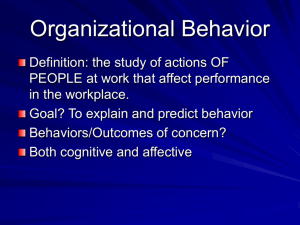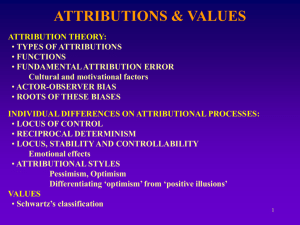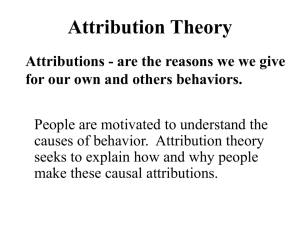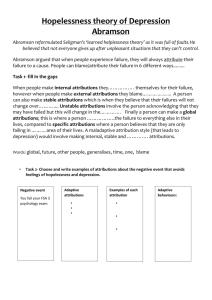Chapter 4 - WW Norton & Company
advertisement
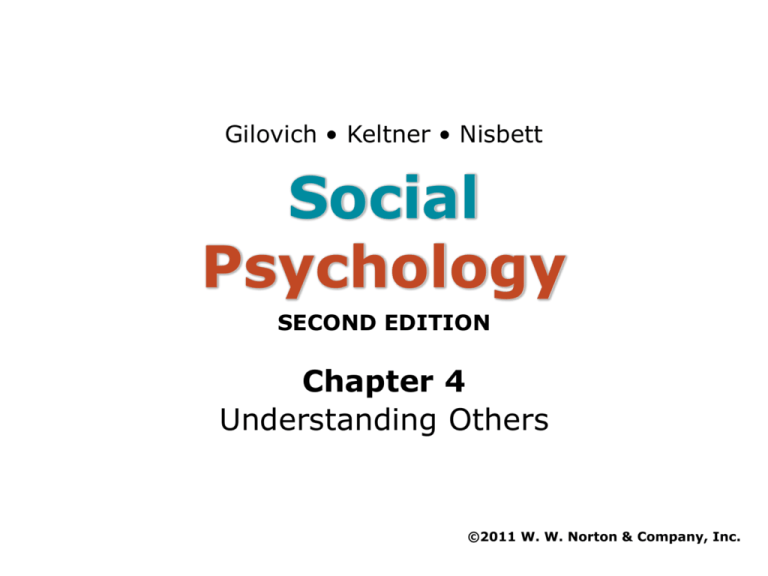
Gilovich • Keltner • Nisbett Social Psychology SECOND EDITION Chapter 4 Understanding Others ©2011 W. W. Norton & Company, Inc. Explaining Events • Attribution theory – General term for theories about how people explain the causes of events they observe • Often make inferences about other people immediately based on their physical appearance – Research shows people with more baby-faced featured as judged as more naïve and trustworthy Explaining Events • Attributions influence behavior towards others – Baby-faced people get more favorable treatment in court but are seen as less appropriate for high responsibility jobs • Snap Judgments – Attributions are often made very quickly based on limited information – Snap judgments can be accurate, but most accurately predict what other people will think Causal Attributions • Causal Attribution – Explanation for the cause of your or another person’s behavior • Importance of Causal Attributions – The type of attribution made will influence how you respond to the situation • For instance, if your friend cancels plans with you. Attributing it the fact that your friend isn’t feeling well will generate a very different reaction than attributing it the the idea that your friend no longer likes Causal Attributions • Internal attribution – Behavior is explained by aspects of the person • External attribution – Behavior is explained by aspects of the situation the person is in Attributions and Health • Explanatory Style – A person’s habitual way of explaining events • Explanatory Dimensions – Internal versus external • Degree that cause is linked to the self or the external situation – Stable versus instable • Degree that the cause is seen as fixed or as something that is temporary – Global versus specific • Degree that the cause is seen as affecting other domain in life or is restricted to affecting specific domains Attributions and Health • Pessimistic attribution style – Internal, Stable, Global attributions habitually made for negative events • “It’s my fault”, “I’m never going to be able to”, “I suck at everything” – Pessimistic attributions styles predict lower grades, poorer physical health later in life Gender differences in Attributions • Gender differences in children’s attribution styles – Boys more likely to attribute failures to external causes – Girls more likely to attribute failure to internal causes Gender differences in Attributions • Differences may be due to elementary school socialization – Study found that teachers gave negative feedback related to intellectual ability to girls and negative feedback related to nonintellectual aspects of behavior – Boys may be inadvertently taught that failures are due to lack of effort while girls may learn that failures are due to ability Covariation Principle • Covariation principle – Behavior attributions made by weighing information about the potential causes of the behavior – Consensus • What would most people do in the given situation Covariation Principle • Covariation principle – Distinctiveness • Whether an individual’s behavior is unique to a given situation or whether that person would the same way in different situations – Consistency • Whether an individual acts the same way in similar situations Covariation Principle Application • External attributions likely if consensus, distinctiveness, and consistency are high – For instance, a person yelling loudly at a football game • Since most people would (high consensus) • If the person doesn’t yell in other situations (high distinctiveness) • The person yells throughout the game or at other football games (high consistency) – Assume the person’s behavior is a product of the situation Covariation Principle Application • Internal attributions likely when consensus and distinctiveness are low but consistency is high – For instance, a person laughing at a funeral • Since most people wouldn’t (low consensus) • If the person laughed in other solemn situations (low distinctiveness) • The person continued to laugh throughout the funeral or at other funerals (high consistency) – Assume there is something unusual about the person Imagining Alternatives • Prior knowledge about the world allows us infer the likely cause of a behavior • Discounting Principle – Principle that less weight should be given to a particular cause of behavior if there are other alternative causes present Imagining Alternatives • Augmentation Principle – Principle that more weight should be given to a particular cause of behavior if the other causes present would have produced an opposite result • Make more inferences about a person when they act in way that are unexpected for the situation Counterfactual Thinking • Causal attributions can be formed by comparing real outcomes to imagined alternatives • Counterfactual Thinking – Thoughts of what might have been, could have been, or should have been “if only” something had been done differently Counterfactual Thinking • Emotional amplification – Emotional reactions to counterfactual thoughts increase depending on how easy it is to imagine the alternative – May feel more personally responsible for failure depending on how easy it is to imagine the alternative • Counterfactual thinking at the Olympics – Seemingly ironic, bronze medalists are often more satisfied with their accomplishment than silver medalists – Silver medalists may imagine a gold medal as the alternative – Bronze medalists may imagine receive no medal as the alternative Errors and biases in attribution • Self-serving bias – Tendency to attribute failures to external causes and success to internal causes • For instance, athletes may attribute loses to bad referees but victories to talent and hard work – Self-serving biases can boost and maintain positive selfesteem Errors and biases in attribution • Fundamental Attribution Error – Tendency to believe that a behavior is due to a person’s traits or disposition despite the situational causes present • For instance, inferences may be made about someone’s true personality even when we are aware that their behavior resulted from an assigned role Reasons for the Fundamental Attribution Error • Motivation to believe in a just world – Motivated to believe that people get what they deserve in life • Good things happen to good people, bad things to bad people – Fundamental attribution errors may be reassuring because feel less vulnerable to external factors influencing our life outcomes Reasons for the Fundamental Attribution Error • Perceptional Salience – Often attribute things to what appears the be most obvious cause – Fundamental attribution errors may occur because people are often more salient than the surrounding context • Automatic and controlled cognitive processing – Dispositional attributions are often made automatically – Situational attributions require more cognitive thought after weighing information about the context Actor-Observer Differences • Attributions may differ between the person engaging in a behavior and a person observing the behavior – The actor is disposed to explain behavior as due to the situation – The observer is disposed to explain behavior as due to dispositional qualities of the actor • For instance, when explaining choice of major for themselves and their friends. Students indicated aspect of the major for their choice, but personality characteristics for their friend’s choice Actor-Observer Differences • Causes of actor-observer differences – Perceptual salience • As actors, the situation is salient. As observers, the person is salient – May ignore the influence of dispositions when explaining our own behaviors – Lack of information about the intentions and past behaviors of the actor Culture and Context • Collectivistic cultures may be more attuned to contextual factors – Emotional Context • When judging the facial expression of an individual, collectivists more influenced by facial expressions of other people in the scene Culture and Context • Collectivistic cultures may be more attuned to contextual factors – Nonsocial Contexts • When describing an animated underwater scene, individualists were more attuned to the focal objects while collectivists described the scene as a whole Culture and Context • Collectivistic cultures may be more attuned to contextual factors – Rod and Frame Test • Individualists perform better at making absolute judgments, but collectivists perform better at relative judgments. • Relative judgments require paying attention to the length of line in context with the frame that surrounds it Culture and Causal Attributions • The fundamental attribution error may be less prevalent in collectivistic cultures – Individualists more likely to attribute behaviors to dispositions – Collectivists more likely to attribute behaviors to the situation • Coaches in the U.S. were more likely attribute wins to abilities of the players Coaches in China were more likely refer to difficulties had by the other team Culture and Causal Attributions • Culture differences in attribution even for non-humans – In one study, participants were shown an animation of a single fish swimming away from a larger group – American participants were more likely to attribute behavior to individual choices of the fish, but Chinese participants to the actions of the group • Attributional differences exist in some American sub-cultures – For instance, Mexican-American and Puerto Rican children were found to make fewer dispositional inferences than Caucasians Priming Culture • For people who are connected to both independent and interdependent cultures, attribution styles may change depending on the cultural context Priming Culture • Evidence from Hong Kong – Hong Kong is heavily influenced by both China and the Western countries like the U.S. and the U.K. – Residents of Hong Kong can switch between independent and interdependent attributions styles • Made more dispositional attributions after being primed with images related to Western culture • Made more situational attributions after being primed with images related to Chinese culture Culture and Personality • The “Big Five” dimensions of personality are the same cross-culturally – For both individualists and collectivists, personalities can be described along traits of openness to experience, conscientiousness, extraversion, agreeableness, and neuroticism • Individualists are more likely to view personality traits as stable, fixed, and unchangeable Culture and Personality • Collectivists more likely to view personality traits can change through effort and changing circumstances • Cultural differences in desire for self-improvement – When given a chance to repeat a task that they had done well or had done poorly, Japanese students chose to repeat the task they had done poorly. Canadian students chose to repeat the task they had done well


